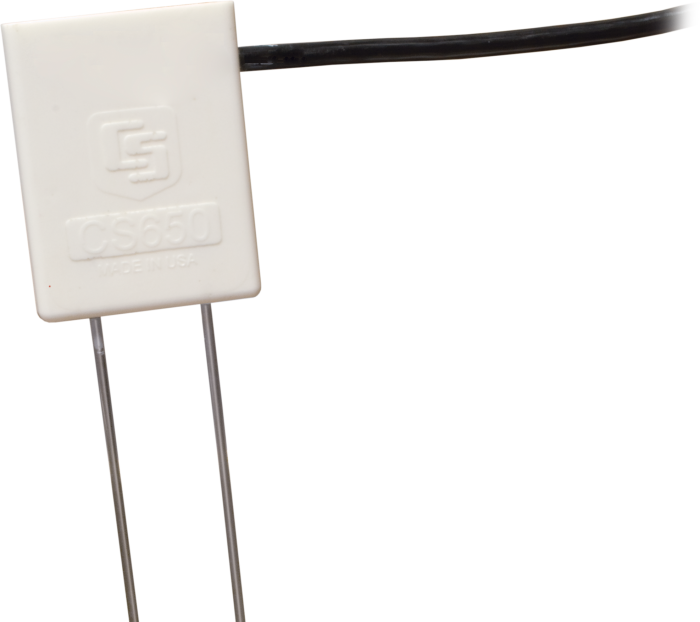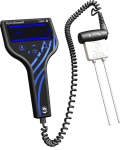
Überblick
Der CS655 ist ein Multiparametersensor der mit Hilfe einer innovativen Technik den volumetrischen Wassergehalt, elektrische Leitfähigkeit und Temperatur des Bodens bestimmt. Er gibt ein SDI-12 Signal aus, das von fast allen unseren Loggern gelesen werden kann. Er hat kürzere Stäbe als der CS650 zum Einsatz in schwierigeren Böden.
Lesen Sie mehrFunktionen und Vorteile
- Größeres Probenvolumen reduziert Fehler
- Messwerte werden korrigiert zur Vermeidung von Effekten durch verschiedene Bodenarten und elektrische Leitfähigkeiten
- Kalkuliert Badenwassergehalt für viele mineralische Böden
- Vielseitiger Sensor, misst elektrische Leitfähigkeit, volumetrischen Wassergehalt, Dielektrizitätskonstante und Temperatur
Bilder

Zugehörige Produkte
Technische Beschreibung
The CS655 consists of two 12-cm-long stainless steel rods connected to a printed circuit board. The circuit board is encapsulated in epoxy and a shielded cable is attached to the circuit board for data logger connection.
The CS655 measures propagation time, signal attenuation, and temperature. Dielectric permittivity, volumetric water content, and bulk electrical conductivity are then derived from these raw values.
Measured signal attenuation is used to correct for the loss effect on reflection detection and thus propagation time measurement. This loss-effect correction allows accurate water content measurements in soils with bulk EC ≤8 dS m-1 without performing a soil-specific calibration.
Soil bulk electrical conductivity is also calculated from the attenuation measurement. A thermistor in thermal contact with a probe rod near the epoxy surface measures temperature. Horizontal installation of the sensor provides accurate soil temperature measurement at the same depth as the water content. Temperature measurement in other orientations will be that of the region near the rod entrance into the epoxy body.
Kompatibel mit
Please note: The following shows notable compatibility information. It is not a comprehensive list of all compatible products.
Datenlogger
| Product | Compatible | Note |
|---|---|---|
| CR1000 (retired) | ||
| CR1000X (retired) | ||
| CR300 (retired) | ||
| CR3000 | ||
| CR310 | ||
| CR350 | ||
| CR6 | ||
| CR800 (retired) | ||
| CR850 (retired) |
Additional Compatibility Information
RF Considerations
External RF Sources
External RF sources can affect the probe’s operation. Therefore, the probe should be located away from significant sources of RF such as ac power lines and motors.
Interprobe Interference
Multiple CS655 probes can be installed within 4 inches of each other when using the standard data logger SDI-12 “M” command. The SDI-12 “M” command allows only one probe to be enabled at a time.
Optional Installation Tool
CS650G Rod Insertion Guide Tool
The CS650G makes inserting soil-water sensors easier in dense or rocky soils. This tool can be hammered into the soil with force that might damage the sensor if the CS650G was not used. It makes pilot holes into which the rods of the sensors can then be inserted.
Spezifikationen
| Measurements Made | Soil electrical conductivity (EC), relative dielectric permittivity, volumetric water content (VWC), soil temperature |
| Required Equipment | Measurement system |
| Soil Suitability | Short rods are easy to install in hard soil. Suitable for soils with higher electrical conductivity. |
| Rods | Not replaceable |
| Sensors | Not interchangeable |
| Sensing Volume | 3600 cm3 (~7.5 cm radius around each probe rod and 4.5 cm beyond the end of the rods) |
| Electromagnetic | CE compliant (Meets EN61326 requirements for protection against electrostatic discharge and surge.) |
| Operating Temperature Range | -50° to +70°C |
| Sensor Output | SDI-12; serial RS-232 |
| Warm-up Time | 3 s |
| Measurement Time | 3 ms to measure; 600 ms to complete SDI-12 command |
| Power Supply Requirements | 6 to 18 Vdc (Must be able to supply 45 mA @ 12 Vdc.) |
| Maximum Cable Length | 610 m (2000 ft) combined length for up to 25 sensors connected to the same data logger control port |
| Rod Spacing | 32 mm (1.3 in.) |
| Ingress Protection Rating | IP68 |
| Rod Diameter | 3.2 mm (0.13 in.) |
| Rod Length | 120 mm (4.7 in.) |
| Probe Head Dimensions | 85 x 63 x 18 mm (3.3 x 2.5 x 0.7 in.) |
| Cable Weight | 35 g per m (0.38 oz per ft) |
| Probe Weight | 240 g (8.5 oz) without cable |
Current Drain |
|
| Active (3 ms) |
|
| Quiescent | 135 µA typical (@ 12 Vdc) |
Electrical Conductivity |
|
| Range for Solution EC | 0 to 8 dS/m |
| Range for Bulk EC | 0 to 8 dS/m |
| Accuracy | ±(5% of reading + 0.05 dS/m) |
| Precision | 0.5% of BEC |
Relative Dielectric Permittivity |
|
| Range | 1 to 81 |
| Accuracy |
|
| Precision | < 0.02 |
Volumetric Water Content |
|
| Range | 0 to 100% (with M4 command) |
| Water Content Accuracy |
|
| Precision | < 0.05% |
Soil Temperature |
|
| Range | -50° to +70°C |
| Resolution | 0.001°C |
| Accuracy |
|
| Precision | ±0.02°C |
Dokumente
Broschüren Produkte
Technische Artikel
Realisierte Projekte
Übereinstimmung mit Richtlinien u. Vorschriften
FAQs für
Number of FAQs related to CS655: 51
Alle anzeigenWenige anzeigen
-
If information is available on soil texture, organic matter content, and electrical conductivity (EC) from soil surveys or lab testing of the soil, it should be possible to tell if the soil conditions fall outside the range of operation of the sensor. Without this information, an educated guess can be made based on soil texture, climate, and management:
- Soil that is coarse textured (such as sand, loamy sand, or sandy loam) works well with a CS650 if the EC is low.
- If the soil is located in an arid or semiarid region, it may have high EC.
- If the soil is frequently fertilized or irrigated with water that has higher EC, it may have high EC.
- If the climate provides enough rain to flush accumulated salts below the root zone, the EC is expected to be low and suitable for a CS650.
When in doubt about soil texture and electrical conductivity, Campbell Scientific recommends using a CS655 because of the sensor’s wider range of operation in electrically conductive soils, as compared with the CS650.
-
Damage to the CS650 or the CS655 electronics or rods cannot be repaired because these components are potted in epoxy. Cable damage, on the other hand, may possibly be repaired. For more information, refer to the Repair and Calibration page.
-
The CWS655 is a wireless sensor with measurement electronics, radio, and power supply all integrated in a single device. The CWS655, however, requires the use of a CWB100 base station radio connected to a datalogger. Only the rods of the CWS655 should be buried in the soil; burying the body of the CWS655 will prevent the sensor from communicating with the CWB100.
The CS655 is a cabled multiparameter smart sensor that sends data by RS-232 serial or SDI-12 communication through a direct connection to a datalogger. The CS655 is suitable for burial at any depth.
-
Yes, but the pots would have to be large. The CS650 and CS655 can detect water as far away as 10 cm (4 in.) from the rods. If the pot has a diameter smaller than 20 cm (8 in.), the sensor could potentially detect the air around the pot, which would underestimate the water content. In addition, potting soil is typically high in organic matter and clay, causing the probable need for a soil-specific calibration.
-
Campbell Scientific does not recommend using the CS650 or the CS655 to measure water content in compost. A compost pile is a very hostile environment for making dielectric measurements with soil water content sensors. All of the following combine to make it very difficult to determine a calibration function: high temperature, high and varying electrical conductivity, high organic matter content, heterogeneity of the material in the pile, changing particle size, and changing bulk density. The temperature and electrical conductivity values reported by the CS650 or CS655 may give some useful information about processes occurring in the compost pile, but these sensors will not be able to give useful readings for water content.
-
No. The principle that makes these sensors work is that liquid water has a dielectric permittivity of close to 80, while soil solid particles have a dielectric permittivity of approximately 3 to 6. When liquid water freezes, its dielectric permittivity drops to 3.8, essentially making it look like soil particles to the sensor. A CS650 or CS655 installed in soil that freezes would show a rapid decline in its volumetric water content reading with corresponding temperature readings that are below 0°C. As the soil freezes down below the measurement range of the sensor, the water content values would stop changing and remain steady for as long as the soil remains frozen.
-
The CS650 and the CS655 are not ideal sensors for measuring water level. However, these sensors do respond to the abrupt change in permittivity at the air/water interface. A calibration could be performed to relate the period average or permittivity reading to the distance along the sensor rods where the air/water interface is located. From that, the water level can be determined. The permittivity of water is temperature dependent, so a temperature correction would be needed to acquire accurate results.
-
The electrical conductivity (EC) of sea water is approximately 48 dS/m. The CS655 can measure permittivity in water with EC between 0 and 8 dS/m. EC readings become extremely unstable at conductivities higher than 8 dS/m and are reported as NAN or 9999999. Because EC is part of the permittivity equation, an EC reading of NAN leads to a permittivity reading of NAN as well. Thus, the CS655 cannot provide good readings in sea water.
With regard to sea ice, the electrical conductivity drops significantly when sea water freezes and the permittivity changes from approximately 88 down to approximately 4, as the water changes from a liquid to a solid state. With both EC and permittivity falling to levels that are within the CS655 measurement range, the sensor is expected to give valid readings in sea ice. The sensor is rugged and can withstand the cold temperatures. However, as the ice melts, there will be a point at which the electrical conductivity becomes too high to acquire a valid reading for either permittivity or electrical conductivity.
-
No. The abrupt permittivity change at the interface of air and saturated soil causes a different period average response than would occur with the more gradual permittivity change found when the sensor rods are completely inserted in the soil.
For example, if a CS650 or a CS655 was inserted halfway into a saturated soil with a volumetric water content of 0.4, the sensor would provide a different period average and permittivity reading than if the probe was fully inserted into the same soil when it had a volumetric water content of 0.2.
-
No. The equation used to determine volumetric water content in the firmware for the CS650 and the CS655 is the Topp et al. (1980) equation, which works for a wide range of mineral soils but not for organic soils. In organic soils, the standard equations in the firmware will overestimate water content.
When using a CS650 or a CS655 in organic soil, it is best to perform a soil-specific calibration. For details on performing a soil-specific calibration, refer to “The Water Content Reflectometer Method for Measuring Volumetric Water Content” section in the CS650/CS655 manual. A linear or quadratic equation that relates period average to volumetric water content will work well.











